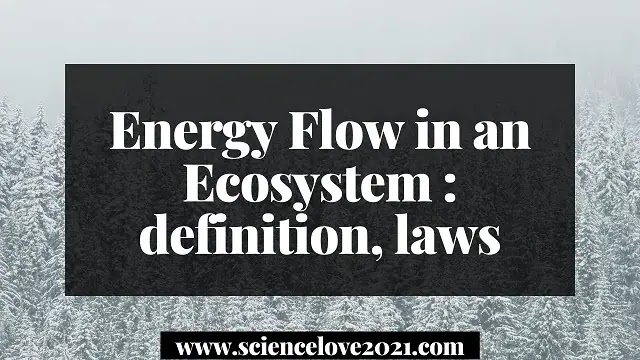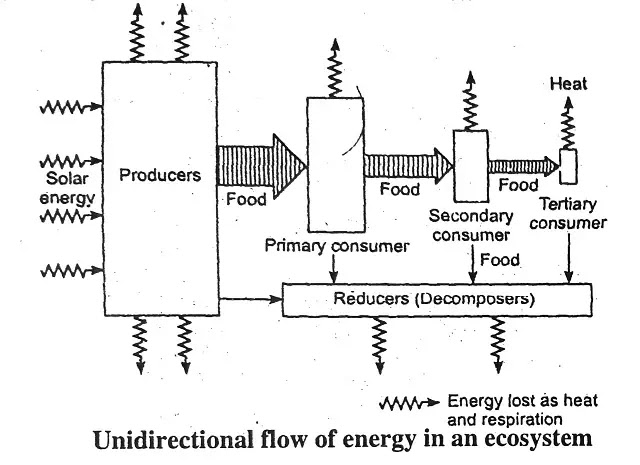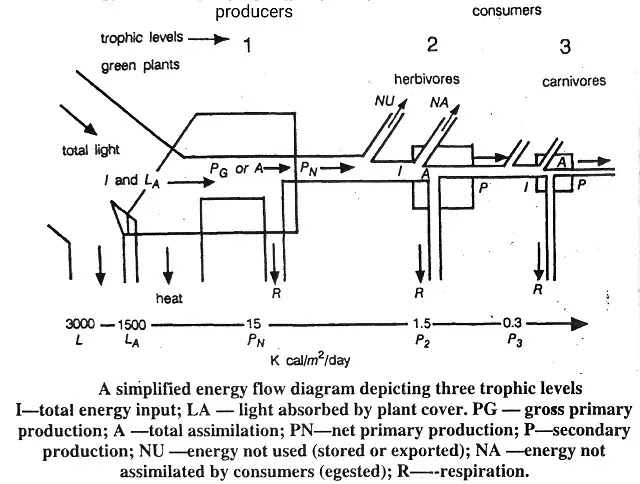The behavior of energy in ecosystem can be termed energy flow due to its unidirectional flow of energy which we can see in food chain and food web. It is essential to understand this from an energetic point of view for an ecosystem
(a) Efficiency of the producers in absorption and conversation of solar energy.
(b) The use of this converted energy by the consumers.
(c) The total investment of energy in the form of food and its assimilation capacity.
(d) The loss through respiration, heat, excretion etc.
(e) The gross net production.
(f) The energy which is absorbed by autotrophs will never revert back to the sun.
Laws Governing Energy Flow
Primary Energy source in an ecosystem is solar energy that is absorbed by green plants. Its flow through different levels and the final loss as heat into space are governed by the two laws of thermodynamics. thus, Sun is the ultimate source of energy which fulfills the requirement of our ecosystem. The energy captured by plants and other autotrophs will never revert back to the sun. Similarly the energy which passes to the herbivore does not go back to autotrophs or plants and so on. Thus the flow of energy is unidirectional.
The first law of thermodynamics states that energy can neither be created nor destroyed but it can change from one from to another form, example - Radiation energy of sun is absorbed by green plants through photosynthesis, is changed into chemical energy stored in glucose molecules. Almost all living organisms (including plants) consume glucose in respiration and stored chemical energy for their metabolic activity. Some of the energy is dissipated as heat, another form of energy.
The second law of thermodynamics states that some useful energy is converted into unusable waste heat during every transformation. Thus in every transformation some energy is always lost in the form of heat that is not available to do further useful work.
The energy flow through an ecosystem can be represented diagrammatically in a simplified manner. In figure the boxes represent the trophic levels and the pipes depict the energy flow in an out of each level. Only about half the average light energy impinging upon the green plants is absorbed in the photosynthetic machinery, out of which one to five percent is converted into food energy and the rest of it passes out as heat in the atmosphere.
Flow of Energy
The energy flow through an ecosystem can be represented diagrammatically in a simplified manner. In Figure the boxes represent the trophic levels and the pipes depict the energy flow in an out of each level. Only about half the average light energy impinging upon the green plants is absorbed in the photosynthesis machinery, out of which 1to 5 percent is converted into food energy and the rest of it passes out as heat in the atmosphere.
The total energy produced during photosynthesis is the gross primary production and is represented by PG or A and the energy left after respiration and stored as organic matter is the net primary production represented by PN. Net primary production actually represents food potentially available to primary consumers or herbivores, The primary consumers, therefore, take in chemical potential energy in the form of plant food. Most of its dissipates in the form of heat (produced during respiration) and is lost out of the ecosystem. Only a smart part of energy is fixed in the form of chemical potential energy in the protoplasm. The same process is repeated at the secondary consumers (primary carnivorous) level and so on. Therefore, at each step in the transfer energy is lost as heat and never returns back to the ecosystem. In the transform of energy through ecosystem, the energy is reduced in magnitude by 100 from primary producers to plant consumers and by 10 for each step thereafter.
According to 10% Low of Lindeman Herbivorous are primary consumers but they can store only 10% of this energy in their biomass and the remaining 90% is used by them in life activities. In the same way herbivorous are eaten by carnivorous, example - lion eats a deer. Thus only 10% of energy of lower trophic level can be captured by the organisms of next higher trophic level. This is known as 10% law.
Primary producers → Herbivorous → Carnivorous → Top consumers (1000 kcal)
(1000 kcal) (100 kcal) (10 kcal) (1 kcal)
Transfer of Energy
Various types in the transfer of energy are -
1. First Step - Green plants absorb about 1 percent of the total energy the sun reaching the earth and by the process of photosynthesis convert it into potential chemical energy. This energy is stored in the plants as carbohydrates. A part of this energy is used by the plants in performing their metabolic activities like growth, respiration, etc. Some of the energy is also released as heat in the environment.
2. Second Step - When plants are eaten by the herbivorous animals, the chemical energy stored in plant food is transferred to the herbivorous animals. Herbivorous animals utilize this energy for their metabolic activities and growth. Here again of the energy is released as heat into the environment.
3. Third Step - The primary consumers or herbivorous animals are eaten by the carnivorous animals. The chemical energy stored in the flesh of herbivorous animals is transferred to the carnivorous animals. Here also some of the energy is lost of the environment as heat. This process is repeated again at every step of the food chain.
This transfer of energy from one trophic level to the other is called transfer of energy in a food chain of an ecosystem.
From the transfer of energy in a food chain, we can conclude following points:
(a) Energy is converted from one form to another but it cannot be created. In fact, plants converted the sun's light energy into chemical energy. We call the plants as producers. But plants do not produce energy. Actually they only convert light energy into chemical energy. The plants are called converters of energy or transducers.
(b) There is continuous transfer of energy from one trophic level to the next trophic level in the food chain. The transfer of energy takes place in the form of energy of food. The energy is transferred from the plants to the herbivores and from herbivores to carnivores:
Plants → Herbivores → Carnivores
(C) At each trophic level, some energy is utilized by the organisms for metabolic activities. Some energy is passed on to the next trophic level and some energy is lost as heat.
(d) The amount of energy available is less at each trophic level than the energy available at the previous level.
(e) The energy lost as heat at each trophic level, it taken together, is quite substantial. There is gradual decrease in the amount of energy available from the first trophic level (plants) to the second trophic level (herbivorous animals) to the third trophic level (carnivorous animals).





No comments:
Post a Comment